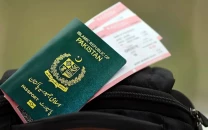Gardening in city by the sea
With the arrival of spring, there are a number of fruits and vegetables one can plant in Karachi.

With the arrival of spring, there are a number of fruits and vegetables one can plant in Karachi. PHOTO: ZAHRA ALI
Spring is in the air, and summer is just around the corner. The question is, what can one plant during this weather? The Express Tribune speaks to a number of experts in the field, who share their advice on the best fruits, vegetables and herbs to grow in the city by the sea.
When to grow
“Spring is here now, it is already a little late as far as planting is concerned,” says renowned horticulturalist Tofiq Pasha Mooraj. “We normally start planting summer veggies from mid-February to mid-March, as temperatures begin to rise in April,” he says.
During this planting season, all summer vegetables can be sown. Winter vegetables are planted in August. Almost all fruits can be grown in Karachi, such as bananas, papayas, pineapples and mangoes. Apples, however, do not grow in Karachi.
“Summer vegetables include all gourds, specially sponge gourd, bitter gourds, okra, tinda (Indian gourd) , beans, some lettuce, tomatoes, peppers, eggplants and more,” says Zahra Ali, who sowed the seeds of an organic garden in her terrace about seven years ago. However, on the same note she informs that during summer, some veggies may be challenging to grow, and must be protected from the heat, “Lettuce and herbs can be challenging to protect in summer, but it is possible to save them by moving them in shade and watering on regular basis.”
A well-known horticulturist, who prefers calling himself a self-taught mali (gardener), and wishes to remain anonymous, says that mint is an all-round favorite in Spring and Summer and grows almost effortlessly in the Karachi climate. Delicate herbs grow better in the winter months when it is a bit cooler, and should be planted in end October till November.

What to grow
“Karachi is blessed with a climate and soil which allows for almost anything to grow,” says the horticulturist.
According to him, fruits that thrive best in Karachi’s climate are chikoo (sapodilla), sharifa (custard apple) and gauva. Another advantage of these trees, along with lemons, is that they can be pruned back regularly, not requiring too much space.
“Where water is available aplenty, coconuts also do well. Mango trees, tamarind and jaman (syzygium cumini) are also local favorites, but being tall trees, require more space,” the horticulturist continues.
When asked about options regarding potted plants, Ali said, “Anything will grow in pots beside the sea, provided it gets protection from the sea breeze. I grow lemongrass, basil, mint and other vegetables including tomatoes, spinach, peppers and beans on my balcony garden in Clifton. Every seasonal crop can be grown in pots or on new patches with river soil and organic material.”

How to grow
The basic guideline is to populate your garden with plants suited for the location. Sunny patches should house hardy plants that can deal with the summer heat. Delicate plants do better in pots in shady areas like car porches and under shady trees.
The horticulturist gives a tip to beginners venturing into gardening, “Some delicate varieties are best kept in pots so they may be moved to shady patches during the peak of summer. A cooling shower in the evenings can help plants cope with the heat stress that builds up in the day,” he recommends.
Mooraj on the other believes that if chosen smartly, there are plants and fruits for every season. “Nature has provided us with plants and fruits to suit every season. Oranges come in the winter when we require Vitamin C, to suit our needs according to the cold climate. Jaman (syzygium cumini) and mangoes too give us relief on hot weather, and help us feel cooler in the summer season,” he says.
No matter how accurately you chose the seeds of the season and how easily you adjust your garden according to the changes in climate, the key is to remember that gardening is a labour of love.
“Gardening we must remember is a labour of love, dealing with living things and sensitivity to the needs of the plant is essential. Today we are fortunate we can search for information on any plant on the internet and learn how best to care for it,” the horticulturist elaborates.
Gardening on a budget
Mango : a small plant Rs350
Papaya : a packet of seeds for Rs100
Chikoo : a small plant Rs350
Banana : a small plant Rs50
Guava : a small plant Rs25
Jaman : a small plant Rs25
Sharifa : a small plant Rs25
Lettuce : a packet of seeds for Rs350
Tomatoes : a packet of seeds for Rs350
Tamarind : a small plant Rs20
Spinach : a packet of seeds for Rs125
Pepper : a packet of seeds for Rs125
Source: Imran Khan, of the Plant Nursery of Karachi
Published in The Express Tribune, March 30th, 2014.
Like Life & Style on Facebook, follow @ETLifeandStyle on Twitter for the latest in fashion, gossip and entertainment.



















COMMENTS
Comments are moderated and generally will be posted if they are on-topic and not abusive.
For more information, please see our Comments FAQ